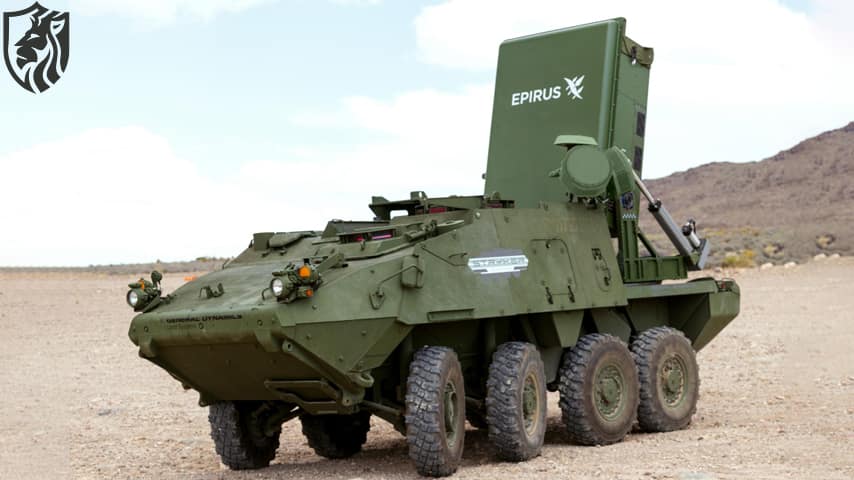
Leonidas High-Power Microwave System
In early April 2025, defense officials confirmed the move, marking a key shift in U.S.-Philippine military ties. This development also shows how important directed-energy weapons are becoming against modern threats like drones.
The deployment aims to boost regional security during rising tensions in the South China Sea. Joint Indo-Pacific exercises increasingly use drones for surveillance and potential aggression.
Placing Leonidas in the Philippines is a smart step for securing a vital trade and security region. It also marks a major leap in military technology and regional preparedness.
From the Middle East to Ukraine, drones now play a central role in modern conflict zones. Drones are cheap, widely available, and capable of complex missions—making them powerful tools for many actors. Both countries and militant groups now use drones to project power in new and unexpected ways.
High-Power Microwave (HPM) Systems
Consequently, militaries have been trying diligently to develop defenses. Leonidas and other high-power microwave (HPM) systems have revolutionized their field.
Unlike conventional kinetic defenses such as missiles or guns, Leonidas employs electromagnetic energy to disable drones by upsetting their electronics. This method allows for the affordable and scalable stopping of swarms of unmanned systems.
Sending it to the Philippines, a significant U.S. ally strategically close to disputed areas, the U.S. is acting proactively to address these concerns in a region where air incursions and maritime conflicts are on the increase.

Made by the defense technology company Epirus, located in California, Leonidas is a solid-state, software-defined HPM system. The system aims to thwart a diverse range of unmanned aerial vehicles (UAVs), encompassing both basic commercial drones and advanced military models.
The system generates a “force field” from a broad microwave beam that might simultaneously disable several drones in its path. This one-to-many characteristic distinguishes it from jamming technologies, which might not be effective against self-driving drones already programmed to follow specific paths, or laser-based systems, which typically attack targets one at a time.
Non-Ionizing Radiation
According to Epirus, U.S. Army assessments show Leonidas has a 100% success rate in tests and can destroy Group 1 and 2 UAVs (up to 55 pounds and flying at low altitudes).
Its modular construction allows it to be coupled to several platforms, including ground vehicles like the Stryker. Under proper management, its non-ionizing radiation keeps surrounding people, weapons, and fuels safe.
The system can expand and run efficiently on just electricity for extended periods of time thanks to intelligent power management.
Leonidas is a rather advanced piece of technology because it can send exact, high-energy pulses that damage drones’ electronics, causing them to lose control or crash.
Each shot from a kinetic interceptive can cost thousands of dollars, and lasers cannot operate in hazardous conditions and depend on a clear line of sight.
Leonidas, on the other hand, is a cheap replacement that minimizes collateral damage. Its software-defined architecture lets users vary the beam’s strength and range so it can handle a range of threats.
Balikatan Exercises
Under the Indirect Fire Protection Capability—High-Power Microwave (IFPC-HPM) program, Epirus signed a $66 million contract from the U.S. Army’s Rapid Capabilities and Critical Technologies Office to deliver four prototype HPM systems.
May 2024 brought delivery of the last two units. U.S. combatant commands have extensively tested these systems to demonstrate their ability to counter a broad spectrum of drone threats.
On this basis, the deployment to the Philippines fits in with the yearly Balikatan exercises, which are a crucial component of military cooperation between the US and the Philippines.
Balikatan 25 in April 2025 displayed many highly advanced technologies. Among them was the Marine Air Defense Integrated System (MADIS), which hunts and battles drones by means of electronic warfare.
Leonidas’s involvement in these drills emphasizes the need to enhance joint air defense, particularly in the South China Sea, where drones are increasingly employed for intelligence, surveillance, and reconnaissance.
The drills took place close to disputed sea areas like Scarborough Shoal and also gave Filipinos more knowledge about advanced anti-drone technologies, helping train their forces to operate alongside U.S. forces and enhancing their capacity for cooperation.
South China Sea
From a strategic standpoint, it is impossible to overestimate the relevance of the Philippines. A key stop on world trade routes, the archipelago lies midway across the South China Sea. Each year, the archipelago transports goods worth over $3 trillion across its seas.
Territorial disputes and more military activity have been driving increasing tensions in the area. Events involving unmanned systems, such as Chinese drones monitoring naval patrols, have raised questions regarding the weakness of the Philippines’ defenses.
U.S. Defense Secretary Pete Hegseth visited Manila in March 2025 to declare increased military cooperation. For instance, the Philippines would receive anti-ship missiles, and Batanes, a province near Taiwan, would train special forces.
Leonidas’s deployment complements these initiatives by offering a non-kinetic approach to combat aerial threats without using conventional weaponry, which may exacerbate the situation.
From the 1951 Mutual Defense Treaty forward, shared security issues have dominated the U.S.-Philippines alliance. Key to projecting American power in Asia during the Cold War were Clark Air Base and Subic Bay, among other American bases in the Philippines.
Agreements like the Enhanced Defense Cooperation Agreement (EDCA) of 2014 have helped military ties to flourish even if these bases closed in the early 1990s.
Defense Cooperation Agreement (EDCA)
The Philippines has been assiduously developing a modernization initiative. One instance of its efforts is the recent U.S. clearance of a purchase of 20 F-16 Block 70 aircraft valued at $5.5 billion to upgrade its air defense.
Including systems like Leonidas in this framework marks a change toward handling asymmetric threats, like drones and other low-cost technologies endangering the military’s conventional supremacy.
F From the standpoint of the Filipino people, Leonidas’s deployment presents both opportunities and challenges. With access to modern U.S. technologies, the Armed Forces of the Philippines can better defend their waters and combat air strikes.
During the Balikatan drills, Filipino marines displayed their drone defense systems, demonstrating that training under American forces has already begun to develop local capabilities. However, the presence of American military forces has sparked debate within the country.

Palawan or Luzon
Concerns about sovereignty and the potential for worsening conditions in an already unstable area worry some Filipino legislators and activists. People have felt this way about the U.S. military presence in the past, particularly following the end of the colonies, when bases were considered both a security precaution and a sign of foreign influence.
As people participate in this deployment, the situation becomes even more challenging. Like those in Palawan or Luzon, people who live close to military bases are both fascinated and terrified about the arrival of advanced technologies such as Leonidas.
Many local residents, who mostly rely on tourism and fishing, are quite aware of the conflicts in the South China Sea that underlie these deployments. While some believe U.S. support will prevent other nations from attacking, others worry it will cause great power rivalries.
Teaching Filipino soldiers how to operate Leonidas provides a significant advantage: it equips local forces with new capabilities that could enhance their ability to protect the nation.
This information exchange complements the Self-Reliant Defense Posture of the Philippines, which aims to reduce reliance on outside aid by enhancing national competencies.
China’s FK-4000 HPM
Leonidas is part of a global technological race, among others, aiming to stop unmanned systems. Similar technologies abound, including China’s FK-4000, an HPM system mounted on a car displayed at the 2024 Zhuhai Airshow, and the British RF Directed Energy Weapon, which blocks radio signals used by drones.
The Chinese system, based on a Type 625E chassis, aims to destroy drones at ranges comparable to Leonidas. This demonstrates Beijing’s progress toward creating directed-energy weapons.
China’s focus on territorial defense aligns with the FK-4000’s apparent rapid deployment in contested areas. This is not the case for Leonidas, who emphasizes scalability and interface with current platforms.
These incidents highlight the worldwide arms race in progress and the growing relevance of HPM technologies in determining military operations, such as missiles or fighter jets.
Leonidas had influences on the economy outside of the battlefield. Epirus has seized the increasing demand for anti-drone products by securing $250 million in Series D financing in March 2025 to enable larger manufacturing capacity.
General Dynamics
Having made this investment, the company has now raised more than $550 million, leading the way in defense technology and earning a value of more than $1 billion.
The company connects new technologies from business to military needs through its work with General Dynamics, adding Leonidas to Stryker vehicles.
If these technologies were accessible, the Philippines could launch its defense sector. Joint ventures or technology transfers could help to accomplish this; no such deals have been made public.
Looking ahead, Leonidas raises important questions about the future of warfare and regional stability in the Indo-Pacific. As AI and autonomous drones evolve, systems like Leonidas must adapt to effectively counter increasingly smarter and more complex threats. The U.S. Army believes in high-powered microwave (HPM) weapons, as shown by its continued investment and real-world trials.
Conclusion
However, if rival nations deploy similar technology, electronic warfare could trigger a dangerous arms race. Future battles may rely more on countermeasures than on firepower. For the Philippines, American support brings both protection and risks tied to broader geopolitical rivalries.
Japan and Australia, which are also U.S. allies, might follow suit with their own deployments, thereby shifting the dynamics of security in the Indo-Pacific region. Leonidas’s deployment demonstrates how technology can transform modern warfare beyond the traditional battlefield. The U.S. and the Philippines are working together to tackle the growing drone threat.
This cooperation builds regional resilience during a time of severe uncertainty. D Directed-energy weapons are rapidly spreading, but their societal impacts remain unclear. Can such weapons stop violence without causing new problems?
Will this initiative change how countries engage in tense areas like the South China Sea? Currently, the Leonidas system acts as a shield against an unknown threat. Its true legacy may lie in the rules it helps define for future conflicts.
References
- Epirus Official Website—https://www.epirusinc.com
- U.S. Department of Defense—https://www.defense.gov
- Indo-Pacific Command News – https://www.pacom.mil/Media/News/
- Defense News Today—https://www.defensenewstoday.info
- Philippines Department of National Defense—https://www.dnd.gov.ph
- U.S. Army Rapid Capabilities Office—https://www.army.mil/rccto
- Balikatan Exercises Coverage—https://www.pacom.mil/Exercise/Balikatan
- Facebook—Pakistan Defense Forum—https://www.facebook.com/groups/pakistandefenseforum
- The Diplomat—https://thediplomat.com
- Reuters: U.S.-Philippines Defense Cooperation—https://www.reuters.com







